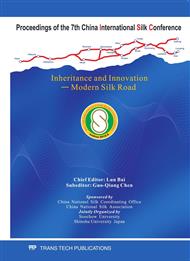p.19
p.25
p.30
p.36
p.41
p.46
p.51
p.56
p.61
Studies on the Joint Impact of Mulberry Cultivation and Sericulture Enterprise as a Scheme for Border Area Development Programme in Kashmir, India
Abstract:
With the Development of New Technologies in Silkworm Rearing though Sericulture Has now Emerged as a Main Profession and a Major Cash Crop for the Rural People of the India in Tropical Areas but in Temperate Belt Like Kashmir the Constraints Faced by the Sericulture Farmers/silkworm Rearers Are More and these Are Responsible for Yield Gaps which Have to Be Considered Seriously and Accordingly the Extension Services Need to Be Modulated and Implemented. Exploitable Yield Gaps in Border Areas Are Often Caused by Various Factors Including Physical, Biological, Socio-Economic and Institutional Constraints which Can Be Effectively Improved through Participatory and Holistic Approaches. Kashmir Is a Univoltine Area where for Generations only one Crop in Spring Season Is Taken between May and June. Spring (May – June, 2009) Data of Kandi Kupwara J&K India (Border Area) Revealed Varying Cocoon Yields from 7 to 13 Kgs Dry Cocoons per 100 DFLS with Cocoon Price Varying from Rs. 172-430 per Kg. these Facts and Figures Prove that these Silkworm Rearers by Realizing the Potential of Sericulture (a New Culture in a Border Area) Increased their Income Substantially from Rs. 720 to Rs.5590/100DFLS. it Was Also Found that Sericulture Productivity Can Be Further Increased by Planting Improved Varieties of Mulberry as it Has Been Observed that where, Very Good Quality Mulberry Leaf and Inputs Are Available, the Sericulture Productivity Is Reasonably Good. the Present Communication, Therefore, Discusses the Extension Strategies and New Technologies to Improve the Essential Knowledge and Skills to the Sericulture Farmers to Improve the Yield and Profitability of Sericulture.
Info:
Periodical:
Pages:
41-45
Citation:
Online since:
January 2011
Keywords:
Price:
Сopyright:
© 2011 Trans Tech Publications Ltd. All Rights Reserved
Share:
Citation:


